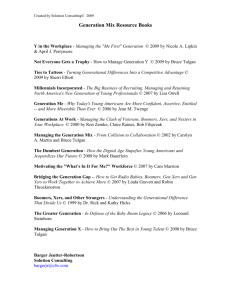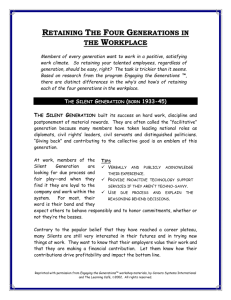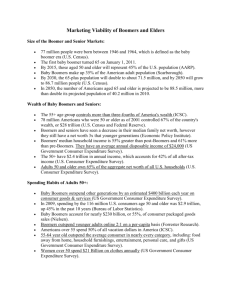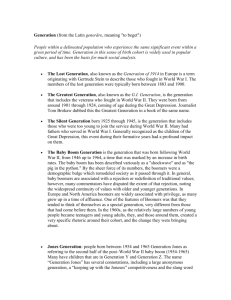Generation X
advertisement
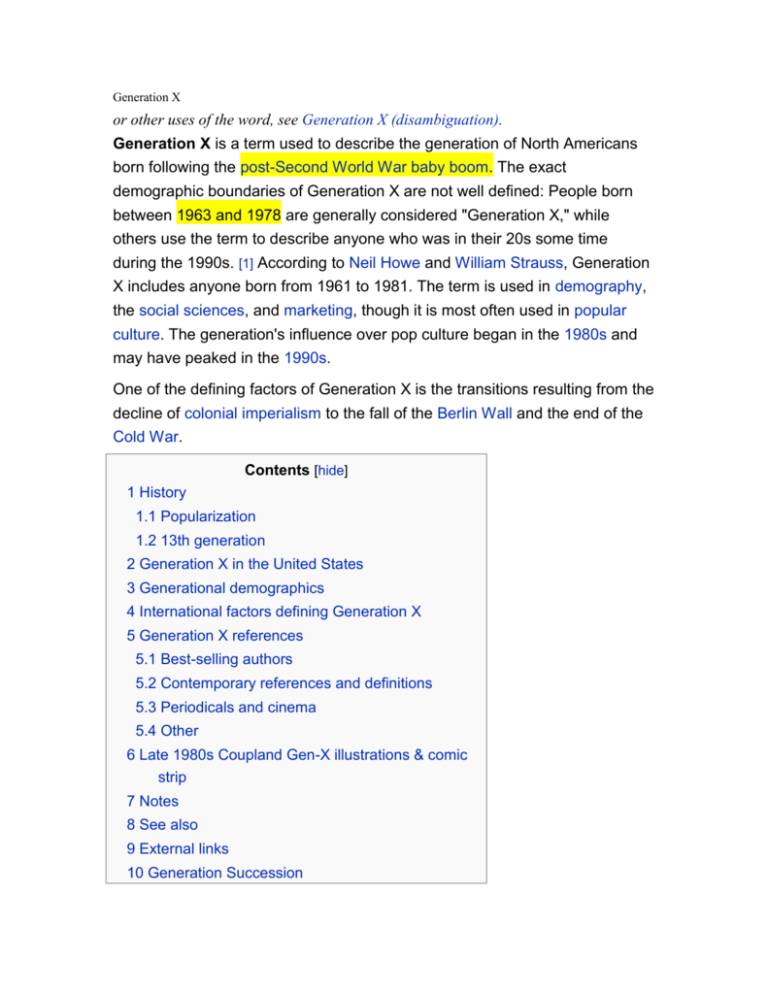
Generation X or other uses of the word, see Generation X (disambiguation). Generation X is a term used to describe the generation of North Americans born following the post-Second World War baby boom. The exact demographic boundaries of Generation X are not well defined: People born between 1963 and 1978 are generally considered "Generation X," while others use the term to describe anyone who was in their 20s some time during the 1990s. [1] According to Neil Howe and William Strauss, Generation X includes anyone born from 1961 to 1981. The term is used in demography, the social sciences, and marketing, though it is most often used in popular culture. The generation's influence over pop culture began in the 1980s and may have peaked in the 1990s. One of the defining factors of Generation X is the transitions resulting from the decline of colonial imperialism to the fall of the Berlin Wall and the end of the Cold War. Contents [hide] 1 History 1.1 Popularization 1.2 13th generation 2 Generation X in the United States 3 Generational demographics 4 International factors defining Generation X 5 Generation X references 5.1 Best-selling authors 5.2 Contemporary references and definitions 5.3 Periodicals and cinema 5.4 Other 6 Late 1980s Coupland Gen-X illustrations & comic strip 7 Notes 8 See also 9 External links 10 Generation Succession [edit] History [edit] Popularization The novel, Generation X: Tales for an Accelerated Culture, popularized the term "Generation X." The term, Generation X, was later popularized by Canadian novelist Douglas Coupland in Generation X: Tales for an Accelerated Culture, which describes the angst of those born between roughly 1960 and 1965, who felt no connection to the cultural icons of the baby boom generation. In Coupland's usage, the X referred to the namelessness of a generation that was coming into an awareness of its existence as a separate group but feeling overshadowed by the Boomer generation of which it was ostensibly a part. Coupland took the X from Paul Fussell's 1983 book Class, where the term "Category X" designated a region of America's social hierarchy, rather than a generation.[2] However, this term has transcended its roots in that country and expanded into other areas of the West. Coupland first wrote of Generation X in September 1987 (Vancouver magazine, "Generation X," pp. 164-169, 194: see illustrations below), which was a precursor to the novel and slightly preceded the term "twentysomething." Coupland referred to those born from 1958 to 1966 in Canada or from 1958 to 1964 in the United States (see trailing edge boomer). As Coupland explained in a 1995 interview, "In his final chapter, Fussell named an 'X' category of people who wanted to hop off the merry-go-round of status, money, and social climbing that so often frames modern existence." As the term Generation X later became somewhat interchangeable with "twentysomething," he later revised his notion of Generation X to include anyone considered "twentysomething" in the years 1987 to 1991.[3] In fact, while the book is often seen as being an accurate description of the generation, Coupland maintains that the book was meant to show the lack of a single description for it. [edit] 13th generation In the book Generations, William Strauss and Neil Howe called this generation the "13th Generation" because it's the 13th to know the flag of the United States (counting back to the peers of Benjamin Franklin). Strauss and Howe defined the birth years of the 13th Generation as 1961 to 1981 based on examining peaks and troughs in cultural trends rather than simply looking at birth rates.[4] Howe and Strauss speak of six influences that they believe have shaped Generation 13. These influences are as follows: Readily-accessible birth control Legalization of abortion on demand Increase in divorce Increase in mothers in the work place The Zero Population movement "Devil-child films" [edit] Generation X in the United States Generation X is generally marked by its lack of optimism for the future, nihilism, cynicism and lack of beliefs and trust in traditional values. Following the publication of Coupland's book (and the subsequent popularity of grunge music) the term stretched to include more people, being appropriated as the generation that succeeded the Baby Boomers, and used by the media and the general public to denote people who were in their twenties. During the early 1990s, the media portrayed Generation X as a group of flannel-wearing, alienated, overeducated, underachieving slackers with body piercings, who drank franchise-store coffee and had to work at McJobs, concepts that had some truth to them but were in many cases stereotypes. As is common in generational shifts, Gen-X thinking has significant overtones of cynicism against things held dear to the previous generation. Another cultural hallmark of Generation X was grunge music, which grew out of the frustrations and disenchantment of X teenagers and young adults. The fashion of grunge music that was exemplified by the band Nirvana expressed the frustrations of a generation forever doomed to live in the shadow of its elders. Others point out that grunge derived its stance and musical values from 1970s punk and heavy metal, and thus was simply part of the wave of 1970s nostalgia that swept college campuses in the early 1990s. Cover of the July 16, 1990 issue of Time magazine, as part of the feature article discussing the twentysomething generation of the 1990s The attitudes of Gen X towards religion can be best described as indifferent to downright hostile. They view Christianity as having nothing to offer them in the church sense, however many of them still believe in God or at least "a higher power". Many, if not most Xers, are completely secularized and abandoned traditional churches. Generation X grew up during the end of the Cold War and the Ronald Reagan eras but as they transitioned into adulthood watched the Soviet Union collapse and the United States of America become the only superpower. Generation X is also the first generation to abandon the traditional family model, to consider divorce as a norm, and to promote singleparent families. Generation X has been left in a state of instability due to social problems such as high crime rates, divorce, children born out of wedlock, and lack of a father figure in many families. Some Xers refer to this as "The Vacuum Effect", which is perpetuated from the Baby Boomers huge size as they move though their own time frame. The employment of Gen X is volatile. The Gen Xers grew in a rapidly deindustrializing Western World, experienced the economic depression of the early 1990s and 2000s, saw the traditional permanent job contracts disappearing and becoming unsecure short-term contracts, experienced offshoring and outsourcing and often experienced years of unemployment or at typical jobs, such as McJobs in their youth. It left many of them overeducated and underemployed. This has left a deep sense of insecurity in Gen Xers, whose usual attitude to work is Take the money and run. They no longer take any employment for granted, as their Baby Boomer parents did, nor do they consider unemployment a stigmatizing catastrophe. The perception of Generation X during the early 1990s was summarized in a featured article in Time Magazine: “ . . .They possess only a hazy sense of their own identity but a monumental preoccupation with all the problems the preceding generation will leave for them to fix . . .This is the twentysomething generation, those 48 million young Americans ages 18 through 29 who fall between the famous baby boomers and the boomlet of children the baby boomers are producing. Since today's young adults were born during a period when the U.S. birthrate decreased to half the level of its postwar peak, in the wake of the great baby boom, they are sometimes called the baby busters. By whatever name, so far they are an unsung generation, hardly recognized as a social force or even noticed much at all...By and large, the 18-to-29 group scornfully rejects the habits and values of the baby boomers, viewing that group as self-centered, fickle and impractical.While the baby boomers had a placid childhood in the 1950s, which helped inspire them to start their revolution, today's twentysomething generation grew up in a time of drugs, divorce and economic strain. . .They feel paralyzed by the social problems they see as their inheritance: racial strife, homelessness, AIDS, fractured families and federal deficits.[1] [edit] Generational demographics In the USA, this generation's parents are the Silent Generation. The subsequent generation, Generation Y have been born of older Generation X parents or Generation X parents having children at a young age, but strikingly also by younger Baby Boomers having children in second and third marriages (resulting in 10-18+ year gaps between the children). Generation Y will have been born in the late 1980s and into the early 1990s. In Western countries, Generation X consists of far fewer people than the baby boom generation and has had correspondingly less impact on popular culture[citation needed], but it came into its own during the late 1980s and early ” 1990s. Hostility between Baby Boomers and Generation X increased in the 1980s and 1990s as Gen Xers accused Baby Boomers of hypocrisy and a "greed is good" mentality and Baby Boomers accused Gen Xers of being slackers[citation needed]. [edit] International factors defining Generation X In continental Europe, the generation is often known as Generation E, or simply known as the Nineties Generation, along the lines of such other European generation names as "Generation of 1968" and "Generation of 1914." In France, the term Génération Bof is in use, with "bof" being a French word for "whatever," considered by some French people to be the defining Gen-X saying. In Iran, they are called the Burnt Generation. In some Latin American countries the name "Crisis Generation" is sometimes used due to the recurring financial crisis in the region during those years. In the Communist bloc, these Gen-Xers are often known to show a deeper dislike of the Communist system than their parents because they grew up in an era of political and economic stagnation, and were among the first to embrace the ideals of Glasnost and Perestroika, which is why they tend to be called the Glasnost-Perestroika Generation. In Finland, the X-sukupolvi is sometimes derogatorily called pullamössösukupolvi (bun mash generation) by the Baby Boomers, saying "those whiners have never experienced any difficulties in their lives" (the depression of the early 1990s hit the Xers hardest--it hit just when they were about to join the work force), while the Xers call the Boomers kolesterolisukupolvi (cholesterol generation) due to their often unhealthy dietary habits. Japan has a generation with characteristics similar to those of Generation X, shin jin rui. Developing countries, too, have a Generation X, but it differs from that in the West, due to poor education and little disposable income. The version of Generation X that the developing nations experience essentially came out of the end of World War II and the subsequent decline of colonial occupation, the changes demanded on social hierarchy that it accompanied among the second generation born since the Second World War, and the duality of democratic transition amid increasing information blockade and everincreasing numbers of people seeking urban life over an agrarian economy. The alleged version of Generation X in the developing world is the following: its need to redefine social norms to newer socio-economic systems the sheer pace at which they need to adapt to new social influences along with the need to integrate them into their native, cultural context the constant aspiration for a more egalitarian society in cultures that were long colonized and have an even longer history of hierarchical social structure. The aspects that bind Generation X across economic levels and cultures are the defining points of the 1970s: the Bretton Woods system and its subsequent failure, the impact of the first oral contraceptive pills on socialinteractional dynamics, and the oil shock of 1973. Other common international influences defining Generation X across the world include: increasingly flexible and varied gender roles for women contrasted with even more rigid gender roles for men, the unprecedented socio-economic impact of an ever increasing number of women entering the non-agrarian economic workforce, and the sweeping cultural-religious impact of the Iranian revolution towards the end of the 1970s in 1979. The international experience of a cultural transition like Generation X, although in various forms, revealed the inter-dependence of economies since World War II in 1945, and showed the huge impact of American economic policies on the world. [edit] Generation X references [edit] Best-selling authors Zemke, Ron & Raines, Claire & Filipczak, Bob "Generations at Work: Managing the Clash of Veterans, Boomers, Xers, and Nexters in Your Workplace" American Management Association, 2000, ISBN 0814404804. 1960-1980 Ritchie, Karen "Marketing to Generation X" Free Press, 2002, ISBN 0743236580. 1961-1981 Tulgan, Bruce "RainmakerThinking, Inc" "Managing Generation X: How to Bring Out the Best in Young Talent" Capstone Ltd, 2003, ISBN 1900961091. Interviewing thousands of Xers, his definition has undergone modification: 1963-1981, with 1961 & 1962 as "cuspers" (1995), based on Strauss & Howe 1963-1977, with 1961 & 1962 as cuspers (1996-2000) 1965-1977, with 1963 & 1964 as cuspers (2001) 1965-1977, with 1960-1964 as cuspers (2002-2006) but usually only referred to as Baby Boomers (1946-1964) in company newsletters 1965-1977 (2007) those born 1946-1953 referred to as "older boomers", 1954-1964 as "younger boomers" Foot, David "Footwork Consulting Inc." "Boom, Bust & Echo: How to Profit from the Coming Demographic Shift" Saint Anthony Messenger Press and Franciscan, 1997, ISBN 0921912978. Generation X are post-birth-peak Boomers, 1960-1966 (Canada), 19581964 (US). Statistics Canada (US Census Bureau equivalent) also observes this demographic based on Foot's research. Smith, J Walker & Clurman, Ann S "Rocking the Ages: The Yankelovich Report on Generational Marketing" Collins; Reprint edition, 1998, ISBN 0887309003. Yankelovich Partners, One of the largest consumer research organizations in the US maintains the years 1965-1978. Trailing Boomers, 1960-1964, are referred to as the bridge between generations. The main distinction between bridgers and Xers is a brief economic boom for the former in the mid-eighties, whereas the latter generational cohort has never been able to presume economic success. "Trailing Boomers thus bridge generations the last Boomers expecting perpetual abundance and the first Xers faced with breakdown and uncertainty." (p. 81) [edit] Contemporary references and definitions The American Heritage Dictionary of the English Language (2000) The generation following the post-World War II baby boom, especially people born in the United States and Canada from the early 1960s to the late 1970s. Compact Oxford English Dictionary (2006) The generation born between the mid 1960s and the mid 1970s, perceived as being disaffected and directionless. Link Magazine: "Marketing Madness: A Postmortem for Generation X" (1997) Examines the divergent age groups ascribed to the Generation X generational cohort by various media and demographers. US Census Bureau "Census 2000 Ethnographic Study" (June 17, 2003) "For the purpose of this study, Generation X is defined as people aged 21 to 32, that is, respondents born during the years 1968-1979. Various studies define Generation X differently by age, with some analyses categorizing people born in 1961 as the cohort's oldest members, while others use a younger upper boundary to demarcate the age group (Craig and Earl Bennett, 1997). Only in hindsight will the boundaries for this cohort become clearer." Statistics Canada "Census Consultation Guide - Age, Sex, and Marital/Common-law Status" (1996/2001) "Generation X. Generation Xers, the back-end boomers [1960-1966], entered the labor market in the early 1980s, when jobs were scarce. Since then, this generation has struggled to gain employment due to a weak economy and the bulk of the jobs being filled by the baby boomers. How will these people cope until the baby boomers begin to retire early in the next century? Are they more inclined to work at two or three jobs or seasonally?" [edit] Periodicals and cinema Time Magazine "Twentysomething" (cover story - July 16, 1990) 18-29 year-olds (1961-1972) "Members of the tail end of the boom generation, now ages 26 through 29, often feel alienated from the larger group, like kid brothers and sisters who disdain the paths their siblings chose." (p. 57) Time Magazine "Great X-pectations" (cover story - June 9, 1997) Three sets appeared in the story: 1965-1977 (p. 58) "If twentysomethings entered the decade floundering in the job market, did they deserve to be labeled dazed and confused?" [1961-1972] (p. 60) 1965-1976 (p. 62) Reality Bites (film)(1994) written by Helen Childress. Plot Outline: An aspiring videographer working on a documentary called Reality Bites about the disenfranchised lives of her friends and roommates. Their challenges, both documented and not, exemplify (perhaps too simplistically) the career and other lifestyle choices and issues faced by their generation. Singles (film) (1992). Plot Outline: A group of twenty-something friends, most of whom live in the same apartment complex, search for love and success in grunge-era Seattle. The soundtrack billed as the "music of a generation searching for itself" (Warner home video). Dr. Jeffrey Jamison (Bill Pullman) 33 years old Eddie Vedder (himself) 28 years old Chris Cornell (himself) Janet Livermore (Bridget Fonda) 23 years old. Main characters' year of birth ranges from 1958-1968 (see "Baby Busters" above). The show "Friends" is often known as a Generation X portrait. The characters were teenagers during the 1980s and have the typical attitude and lifestyle of their generation, especially in the employment and relationships subjects. Slacker (film) (1991). Much of the cast was born in the early 1960s "Tweeners", with others in the late 1950s and late 1960s, spanning the Baby Bust years. [edit] Other A professional wrestling faction from the then WWF now WWE made it part of their namesake, claiming that they were degenerates from Generation X, and formed the faction D-Generation X. Over the last ten years, D-Generation X has gone on to become one of the most popular and contoversial factions in wrestling history. [edit] Late 1980s Coupland Gen-X illustrations & comic strip Vancouver Magazine, Vancouver Magazine, Vista Magazine, 1988. One September, 1987. Back-end September, 1987. of Coupland's "Generation Boomers did not experience Generation X Pop-Quiz. X" comic strips featuring "duck and cover" drills, Castro, Kennedy, Viet-Nam, "The Beaver", Black Power, coonskin caps, Mercury "Brad X". (part 1) (p program, Apollo Moon landing, Woodstock, British invasion, etc. [edit] Notes ^ Ted Rall, MARKETING MADNESS: A Post-Mortem for Generation X, 1997. ^ Interview with Douglas Coupland on CNN's Heads Up, May 28, 1994. ^ Smyth, Michael. "Review of Generation X". Calgary Herald. January 21, 1992. ^ Strauss, William & Howe, Neil. Generations: The History of America's Future, 1584 to 2069. Perennial, 1992 (Reprint). ISBN 0-688-11912-3 [edit] See also XY Cusp, also known as MTV Generation [edit] External links CBC Digital Archives – Generation X: Lives on Hold [http://www.bicentennialbaby.com / Bicentennial Baby: Musings on Generation X and Y [edit] Generation Succession Preceded by Generation X Succeeded by Baby boomers (1958-65) – (1975-81)* [3] [4] Generation Y (1943-1946) – (1957-1964)* (1976-1982) – (1995-20 [4] Retrieved from "http://en.wikipedia.org/wiki/Generation_X" Categories: Articles which may contain original research | Articles with unsourced statements since February 2007 | All articles with unsourced statements | 1960s births | 1970s births | American generations [4]

